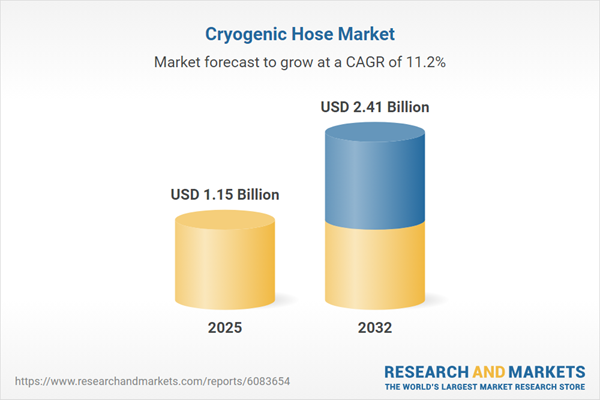Speak directly to the analyst to clarify any post sales queries you may have.
The cryogenic hose market is transforming as industrial buyers demand specialized, safe solutions for low-temperature fluid transfer. As compliance and operational complexities rise, senior decision-makers require actionable insights to navigate fast-changing supply chains and performance requirements.
Market Snapshot: Growth and Opportunities in the Cryogenic Hose Market
The global cryogenic hose market expanded from USD 1.03 billion in 2024 to USD 1.15 billion in 2025, maintaining strong growth at an 11.15% CAGR, with forecasts showing the market reaching USD 2.41 billion by 2032. This momentum is fueled by rising investments in industrial gas infrastructure and adoption of advanced materials in hose manufacturing. Broader usage in renewable energy, as well as advances in digital fluid management, are supporting continued industry adoption. Regulatory changes—particularly relating to compliance and certification—are pushing businesses to re-evaluate sourcing and risk management strategies.
Scope & Segmentation: Diverse Applications and Innovation
- End Use Industries: Chemicals and petrochemicals, food and beverage processing, healthcare and hospital systems, industrial gases, liquid natural gas (LNG), oil and gas (downstream, midstream, upstream).
- Product Types: Composite insulated hoses, hose assemblies, metal corrugated hoses (Inconel, stainless steel), suction and discharge hoses, and specialized hoses for rigorous environments.
- Fluid Categories: Liquid argon, hydrogen, nitrogen, oxygen, and LNG—including critical handling and transfer applications across industrial and process facilities.
- Materials: Composite constructions, PTFE-lined hoses (single and double lining), insulated rubber variants, and stainless steel (grades 304, 316, 321) tailored for varying service conditions.
- Performance Profiles: Solutions span low to ultra-high pressure (exceeding 3000 Psi) and operating temperatures as low as -196°C, ensuring robustness for essential operations.
- Geographical Coverage: Coverage extends across North, South, and Central America (including the United States, Canada, Mexico, Brazil, Argentina, Chile, Colombia, Peru), Europe, Middle East, Africa (including the UK, Germany, France, Russia, Italy, Spain, Netherlands, Sweden, Poland, Switzerland, UAE, Saudi Arabia, Qatar, Turkey, Israel, South Africa, Nigeria, Egypt, Kenya), and Asia-Pacific (China, India, Japan, Australia, South Korea, Indonesia, Thailand, Malaysia, Singapore, Taiwan).
Key Takeaways for Senior Decision-Makers
- Continual upgrades in composite reinforcements and insulation methods enable cryogenic hoses to operate longer in demanding environments such as manufacturing plants and storage depots.
- Strategic supplier collaboration is vital as procurement trends fluctuate; agile networks help reduce exposure to raw material risk and ensure consistent operational reliability.
- Advancements in regulatory frameworks drive the need for up-to-date certification, improved traceability, and product innovation—helping safeguard employees and assets in cryogenic fluid handling.
- Growth in LNG infrastructure and renewables is increasing demand for custom-designed, space-efficient hoses, especially for new build projects and decentralized facilities.
- Implementing digital monitoring tools and predictive maintenance enhances asset utilization, delivering data-driven insights for maintenance scheduling and investment optimization.
Tariff Impact on Supply Chains and Sourcing
Recent U.S. tariff measures are prompting market participants to adapt their procurement and manufacturing strategies. Businesses relying on imported metal and polymer inputs are diversifying their supplier base and investing in domestic or nearer-shore partnerships. These changes are helping companies achieve increased pricing transparency and stronger supply chain resilience. Adoption of modular production processes, combined with digital quality monitoring, is enabling greater flexibility in response to trade and regulatory shifts. Comprehensive scenario modeling and risk assessments are now a central part of sourcing decision-making, reducing exposure to future disruptions.
Methodology & Data Sources
The report synthesizes direct input from engineering executives, procurement leads, and technical operations staff across the cryogenic hose value chain. Findings are supported by on-site visits and operational audits. Additional evidence is integrated from technical standard documentation, supplier catalogs, and peer-reviewed academic resources to ensure thorough validation.
Why This Report Matters
- Presents segmented, region-specific insights, empowering senior leaders to make risk-sensitive procurement and investment decisions tailored to each operational context.
- Equips organizations with actionable intelligence on compliance, technology uptake, and applications that shape corporate priorities and supply planning.
- Enhances agility and supply chain resilience through analysis of supplier diversification, material advances, and the integration of digital workflow solutions.
Conclusion
As innovation, compliance, and new end-use opportunities shape the cryogenic hose market, data-driven insights from this report help leaders align strategy, accelerate product development, and ensure organizational readiness for ongoing shifts in the industrial landscape.
Table of Contents
3. Executive Summary
4. Market Overview
7. Cumulative Impact of Artificial Intelligence 2025
Companies Mentioned
The companies profiled in this Cryogenic Hose market report include:- Parker Hannifin Corporation
- Eaton Corporation plc
- Trelleborg AB
- ContiTech AG
- Semperit AG Holding
- ALFAGOMMA S.p.A.
- Kuriyama of America, Inc.
- Dixon Valve & Coupling Company, LLC
- Flexicraft Industries, Inc.
- Matrix International, Inc.
Table Information
| Report Attribute | Details |
|---|---|
| No. of Pages | 190 |
| Published | October 2025 |
| Forecast Period | 2025 - 2032 |
| Estimated Market Value ( USD | $ 1.15 Billion |
| Forecasted Market Value ( USD | $ 2.41 Billion |
| Compound Annual Growth Rate | 11.1% |
| Regions Covered | Global |
| No. of Companies Mentioned | 11 |









